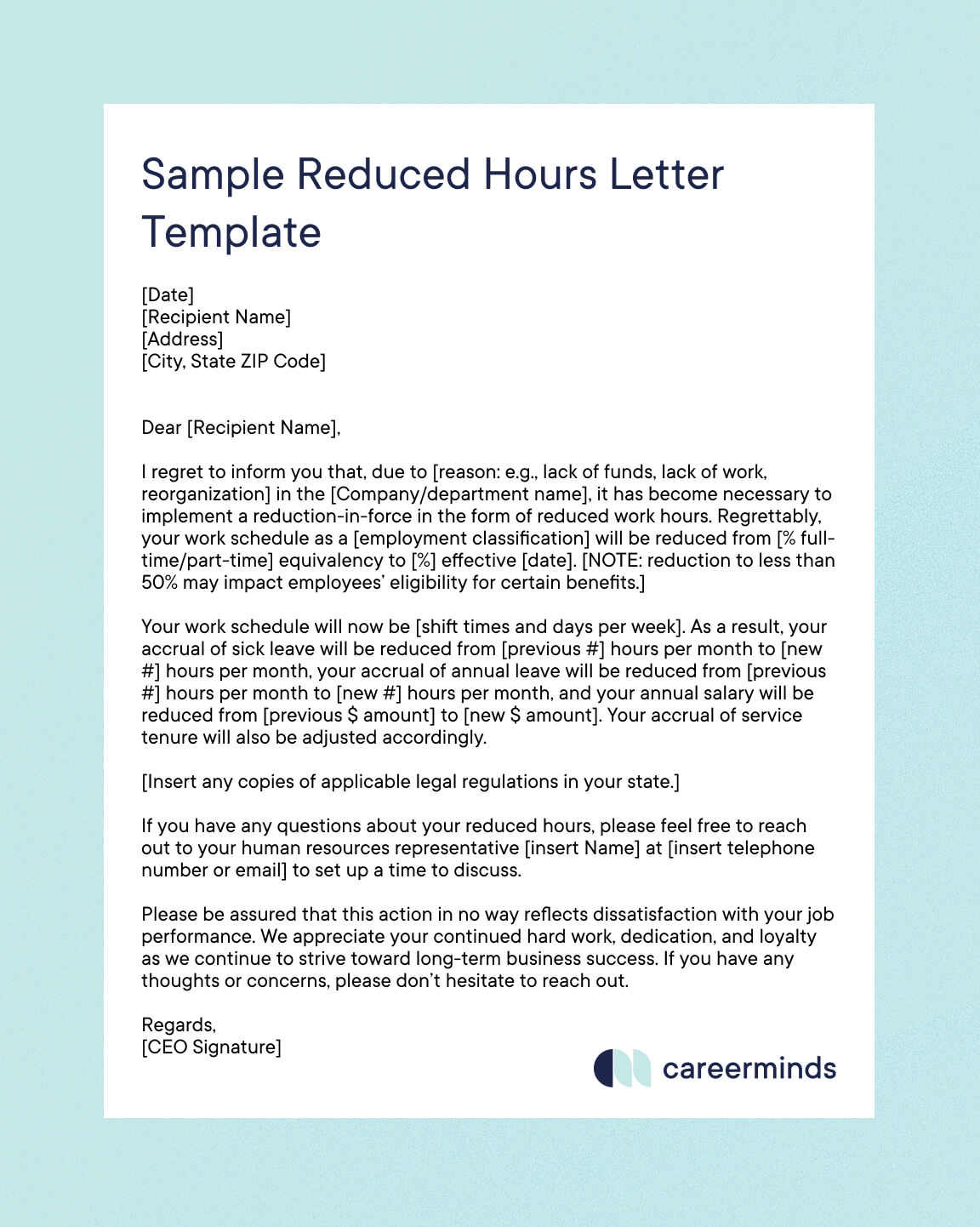
How to Write an Employee Reduced Hours Letter (Template Included)
January 08, 2025 Written by Rebecca Ahn

Compare Providers
Download our outplacement comparison sheet
Request Pricing
Compare our rates to other providers
Reduced work hours are never fun for human resources professionals to announce. When an organization reduces work hours, it usually means that financial turmoil is striking the organization. This creates stress not only for the human resources team executing the reduction in hours, but also for the employees who have to manage the stress of losing pay (and potentially benefits), as well as the long-term stability of their job if the company is in trouble.
Despite this added stress, however, reducing work hours can still be a great option for organizations who need to limit their expenses without laying off employees. They can eliminate costs associated with working hours and employee benefits, while still maintaining the size of their workforce. As a result, reducing employee work hours is a common last-ditch effort to turn things around for a company before it reaches the point where layoffs are necessary.

How Do I Write a Reduced Hours Letter Template?
The first crucial step to implementing reduced work hours is to compose a thorough and thoughtful employee reduced hours letter. This letter needs to be carefully crafted to ensure you can implement your reduction in hours without damaging employee retention or morale. A helpful way to do this is to create a reduced hours letter template ahead of time, so that you have it ready to edit and send to employees when the time comes.
Sample Reduced Hours Letter Template
Let’s start with a sample letter to employees regarding working hours to give you an idea of what your own reduced hours letter should include. Below is our sample reduced hours letter template for employees that you can copy and customize for your own organization.
COPYABLE EXAMPLE
[Date]
[Recipient Name
[Address]
[City, State ZIP Code]
Dear [Recipient Name],
I regret to inform you that, due to [reason: e.g., lack of funds, lack of work, reorganization] in the [Company/department name], it has become necessary to implement a reduction-in-force in the form of reduced work hours. Regrettably, your work schedule as a [employment classification] will be reduced from [% full-time/part-time] equivalency to [%] effective [date]. [NOTE: reduction to less than 50% may impact employees’ eligibility for certain benefits.]
Your work schedule will now be [shift times and days per week]. As a result, your accrual of sick leave will be reduced from [previous #] hours per month to [new #] hours per month, your accrual of annual leave will be reduced from [previous #] hours per month to [new #] hours per month, and your annual salary will be reduced from [previous $ amount] to [new $ amount]. Your accrual of service tenure will also be adjusted accordingly.
[Insert any copies of applicable legal regulations in your state.]
If you have any questions about your reduced hours, please feel free to reach out to your human resources representative [insert Name] at [insert telephone number or email] to set up a time to discuss.
Please be assured that this action in no way reflects dissatisfaction with your job performance. We appreciate your continued hard work, dedication, and loyalty as we continue to strive toward long-term business success. If you have any thoughts or concerns, please don’t hesitate to reach out.
Regards,
[CEO Signature]
Feel free to copy and customize this free reduced hours letter template doc to craft your own employee reduced hours letter. Of course, this example is provided for illustrative purposes only, and does not constitute legal advice. Remember to review all of your reduction event communications with your legal team before sending anything to your employees to ensure that you comply with all applicable laws.
Before we dig into the logistics of having a reduction in work hours, make sure to download our sample letter to announce your reduction to employees. Click below to download that as part of our free Reduction Resources Guide designed to help you implement the right cost reduction strategy for your organization that will have the least impact on your employees and company brand.
What Should You Include in a Reduced Hours Letter?
Now let’s break down this reduced hours letter template doc to understand its key components. When creating a letter to notify your employees of their reduced work hours, you will want to use language that is clear and simple. It’s good to follow a specific content structure to help you include all of the key information and avoid any problems later on.
Here are the six key components you should include in your employee reduced hours letter:
1. Reduced Hours Explanation
To start the letter, announce that your organization will be having a reduction in force (RIF) in the form of reduced work hours. Then take a sentence or two to explain what “reduced work hours” means and the reason for it, as you may have a few employees who’ve never heard of it before.
2. Reduced Hours Details
Next, you will want to clarify when and by how much your employees’ work hours will be reduced. This could be different for employees in different areas or roles in the organization, so pay special attention to these fields as they correspond with each recipient. Your letter should also explain what percentage of full-time employee status each employee previously was, and what they will now be after the reduction in hours. Finally, make sure to include this employee’s new work schedule in the letter.
3. Reduced Pay and Benefits
In accordance with the reduction in work hours above, your letter should explain how pay and benefits will be impacted. This includes any change in salary, sick leave, paid vacation time, healthcare, and financial benefits. You will also want to state whether or not these reduced hours will change the employees’ overall tenure at an organization (as this could impact retirement).
4. Applicable Laws and Regulations
To be cautious, we also recommend including in the letter a copy of any applicable laws or state regulations regarding how an organization must handle reduced work hours. This provides visibility to the employees, and helps reduce any liability on your part.
5. Contact Information
It is always good to give instructions to employees about how they can follow up with human resources if any issues or questions arise with their reduced work hours. Providing an opportunity to voice concerns and appeals is also required of some organizations by state law. Check with your legal counsel to see what the requirements are in your area.
6. Positive Acknowledgement
End the letter with words of appreciation for your employees’ hard work, dedication, and continued loyalty to your organization, making it clear that the reduction in hours is not a reflection of their job performance, and that they are still valued and needed.
The Pros and Cons Of Reducing Work Hours
Reducing employee work hours is a great way for an organization to turn around their financial situation if things start to head south. It’s not as drastic as a layoff, and will likely be more positively received by employees, stakeholders, and the public. This means it will be less damaging to your employer brand, which is great news for your long-term hiring, retention, and overall business success.
That said, reducing work hours can come with a few notable challenges:
Sustaining Profitability
First, the logistics of implementing this approach can be overwhelming to managers and human resources. If your organization needs to turn around its profitability, you will need to maintain a sufficient level of operations to generate enough revenue. Your managers and human resources team will need to know exactly how much worker input is needed to reach this point, and factor that into the reduction-in-hours plan.
While this sounds simple, it can be hard in a large organization to clarify what the revenue goals are and how much input is needed from each team to successfully meet them. This is generally where workforce planning comes in handy. You can learn more about it here:
Adjusting Work Schedules
Reduced work hours can also become a logistical nightmare with scheduling, especially if you have specific shifts that need to be covered. Let’s say your organization has a typical three-shift schedule: the first shift at 8am-4pm, the second shift at 4pm-12am, and the third shift at 12am-8am.
If you reduce the hours of your employees working these shifts, will you have idle time within these windows that is more difficult to cover? Will you need to move some of your workers to different days or shifts to cover the less staffed periods?
These logistical issues can prove difficult for your employees as well, forcing them to rethink the schedules and plans in their personal lives, such as child care. So make sure you are mindful of these challenges when reducing their work hours.
Maintaining Morale and Retention
Finally, reducing work hours can be a major morale killer for your employees. Not only are they frustrated by the sudden change in their schedule and reduction in pay, but they are also unsure about the stability of their job over the long run due to the company’s financial issues.
Let’s imagine an example employee at your organization. This employee is a single dad who relies solely on the income of his employment with your organization. With the reduction in work hours, he has less income to pay for his rent and other living expenses. He also has a different schedule, so he might need to figure out alternative child care options and miss some of the night classes he’s taking on the side to advance his career.
The stress this employee faces due to the reduction of his work hours at your organization is significant. And that’s just one example. There will likely be many people in your organization who will be impacted by the reduction in hours and feel just as—if not more—stressed by the change.
This is why many organizations opt to skip over reducing work hours and instead hold a voluntary layoff. This allows people like that example employee, whose life will be extremely impacted by the reduction in hours, the ability to keep his normal schedule because the company is able to let go of other employees who actually want to leave.
How To Evaluate Your Reduction in Work Hours
If your human resources team takes the time to craft a reduced hours letter template and implement this reduction in hours, you should have a plan in place to evaluate whether it worked for your organization.
To develop an evaluation plan, you first need to understand the goals of your reduction-in-hours event. Do you want to eliminate costs over the holidays? Are you looking to increase profits? Ask your executives for clarification on this, and then develop an evaluation plan based on the business goals.
Here are some key metrics that you should be tracking during your reduction in hours for this evaluation:
Employee Engagement and Morale
To track employee engagement and morale, send out a company-wide anonymous survey before, during, and after the reduction-in-hours event. Ask questions about their level of engagement, motivation, and satisfaction, and then develop an overall score based on their answers. Compare your average scores from the three different time periods when you sent out the surveys to identify any trends.
Employee Productivity
Calculating employee productivity is difficult, because it can be done in many ways. If the work output of your employees’ hours is a hard product, then their production could serve as your measure of productivity. If the work output is in sales, then the number of deals that the employees generate could be a measure of productivity. The key here is to find a way to measure it, and then compare the productivity levels from before, during, and after the reduction in work hours.
Revenue Generated per Employee
You also need to track any difference in revenue generated by employees throughout this process. This can be easily done by dividing the overall amount of revenue generated by your total number of employees.
Total Growth Toward Executive Goals
Lastly, you will want to measure overall progress toward the business goals you identified with the help of your executive team. That will depend on what those goals are and how they are calculated, but will be much easier to do if you set SMART goals that are specific, measurable, and time-bound. This high-level analysis is essential to the final evaluation of your reduction-in-hours event.
What To Do Next After Your Reduction in Work Hours
If your reduced work hours solved the challenges your organization was trying to face, your human resources and leadership teams will want to spend time creating strategies that can keep these challenges at bay moving forward.
If your reduction in hours doesn’t successfully achieve your goals, you may need to come up with another plan to help your organization improve its bottom line. This could be a furlough, unpaid sabbaticals, voluntary layoff or voluntary retirement event, or even layoffs.
To choose between these next steps, revisit the long-term business goals with your executives again, and then use that information to pick which type of event makes most sense. For example, if your executives just want to keep costs low over the summer, but don’t see a need to eliminate all of the workers, it might be smartest to implement a furlough.
Reduced Hours Letter Template: Final Takeaways
A properly prepared employee reduced hours letter is essential to ensure a reduction-in-hours event from start to finish. So it’s important that you prepare a thorough and thoughtful reduction hours letter template that allows you to explain the reasons and details for the reduced work hours, the impact on pay and benefits, and all other pertinent information for your impacted employees.
As you use the sample letter to employees regarding working hours that we provided above to craft your own reduced hours letter template, make sure to fully customize it for your organization and situation. Finally, remember to always work closely with your legal counsel to ensure that you are including all necessary language and complying with all applicable laws when holding any reduction or cost saving event.
At Careerminds, we believe that you can never be too prepared for your next reduction event. Our arsenal of resources, templates, guides, and industry-leading outplacement services can help you navigate the delicate reduction process. Click below to speak with one of our experts and see if we are the right partner for your organization.
In need of outplacement assistance?
At Careerminds, we care about people first. That’s why we offer personalized talent management solutions for every level at lower costs, globally.



